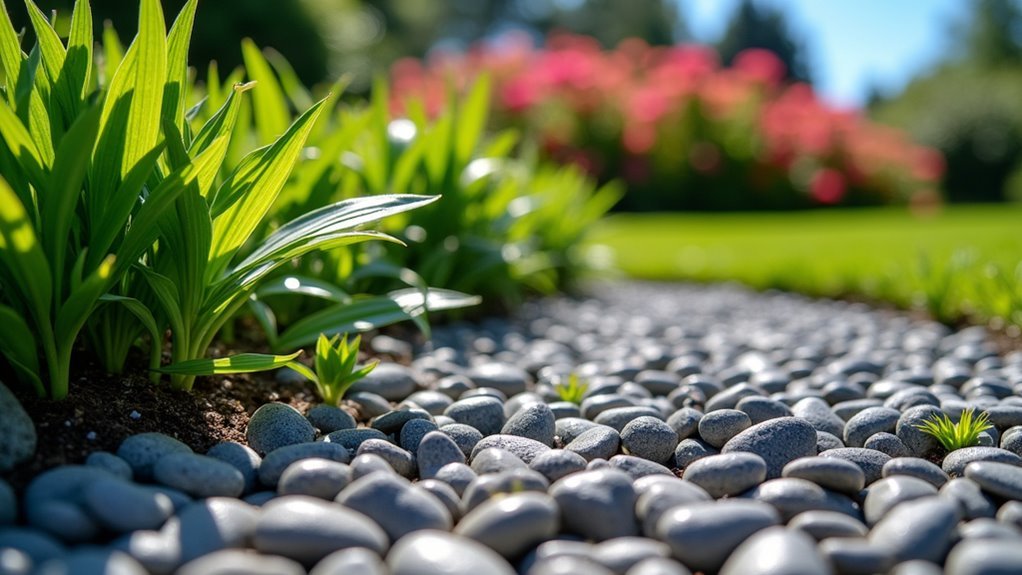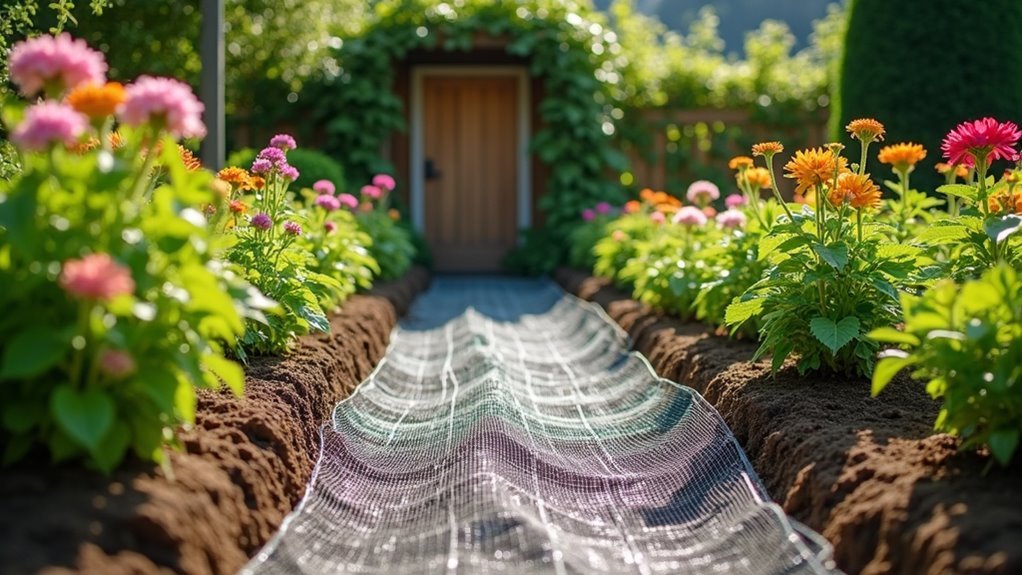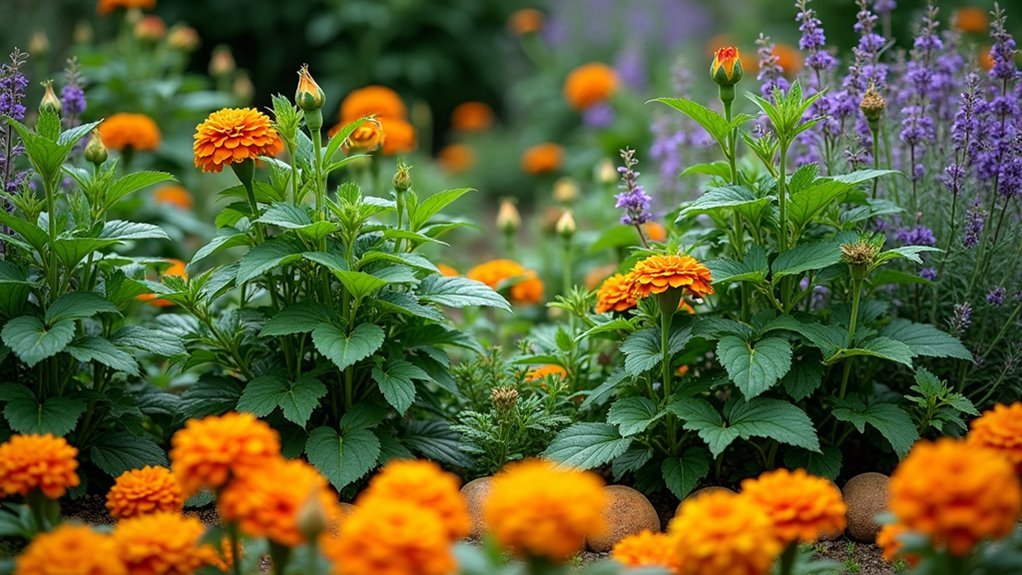You can strategically design your garden to naturally repel rodents by creating elevated beds 12-24 inches high and installing aromatic barriers using mint, lavender, and garlic around your perimeter. Replace organic mulch with gravel or stone to eliminate cozy nesting spots, and maintain clear sight lines by avoiding dense ground cover. Install underground hardware cloth barriers and position storage areas at least 30 feet from your house. These design secrets create an all-encompassing defense system that’ll transform your outdoor space.
Plant Strategic Aromatic Barriers Around Your Garden Perimeter

Fragrance becomes your garden’s first line of defense when you plant strategic aromatic barriers around your perimeter. Aromatic plants like mint, lavender, and rosemary create powerful scent boundaries that prevent rodents from entering your garden space. Their strong fragrances naturally repel unwanted visitors without harmful chemicals.
Position alliums such as garlic and onions along your garden’s edges to establish a pungent protective barrier. These plants release compounds that rodents instinctively avoid.
Complement this defense with diverse herb borders featuring basil and thyme, which produce intense fragrances while adding beauty to your landscape.
Don’t overlook flowering bulbs like daffodils and tulips, whose toxic properties provide additional rodent protection.
Maintain these aromatic barriers regularly throughout the growing season, invigorating plantings as needed to guarantee maximum effectiveness against persistent garden invaders.
Elevate Garden Beds to Limit Rodent Access Points
You’ll discover that elevating your garden beds creates a powerful physical barrier against rodents while delivering multiple gardening advantages.
Raising beds at least 12-18 inches off the ground makes it considerably harder for mice, rats, and other pests to access your plants directly.
This strategic height also improves drainage and soil aeration, creating healthier growing conditions that naturally discourage rodent activity.
Raised Bed Benefits
Raised garden beds offer a strategic advantage against persistent rodents by creating physical barriers that force these pests to work harder for access to your crops.
When you construct raised beds at least 12 to 24 inches high, you’ll greatly limit climbing opportunities for rodents in your garden while preventing them from easily burrowing into your soil and disrupting root systems.
You can enhance protection by installing gravel or metal mesh at the base, creating an additional deterrent against underground access.
These elevated structures also improve drainage and soil quality, resulting in healthier plants that better withstand pest damage.
The improved soil conditions in raised beds stay drier and well-maintained, reducing moisture levels that typically attract rodents seeking food and shelter.
Proper Height Guidelines
Understanding the ideal elevation for your garden beds determines how effectively you’ll block rodent access to your plants. You’ll need strategic height planning to create an effective barrier against unwanted pests.
| Height Range | Rodent Deterrence | Access Difficulty | Maintenance Level | Recommended Use |
|---|---|---|---|---|
| 12-18 inches | Moderate | Medium | Easy | Small gardens |
| 18-24 inches | Good | High | Moderate | Standard beds |
| 24+ inches | Excellent | Very High | Easy | Premium protection |
| 30+ inches | Maximum | Extreme | Very Easy | Accessible gardening |
| 36+ inches | Ultimate | Nearly impossible | Easiest | Mobility considerations |
Your elevated beds should reach at least 2 feet tall for superior rodent deterrence. This height creates a challenging obstacle that discourages burrowing and climbing attempts while maintaining comfortable gardening access for you.
Use Gravel and Stone Mulch Instead of Organic Materials

You’ll find that switching from organic mulches to gravel and stone creates an unwelcoming environment for rodents while boosting your garden’s functionality.
These materials won’t provide the cozy nesting spots that bark chips and leaves offer, and they’ll improve drainage around your plants.
Let’s explore how gravel mulch benefits your garden and the best techniques for installing stone materials effectively.
Benefits of Gravel Mulch
While organic mulches like wood chips and straw create cozy hideouts for unwanted rodents, gravel mulch offers a brilliant alternative that’ll transform your garden into a pest-resistant paradise.
You’ll eliminate those tempting nesting spots that attract mice and rats to your landscape. The sharp edges make burrowing uncomfortable, keeping rodents at bay naturally.
Gravel mulch improves drainage while preventing soil erosion, creating conditions rodents hate. Since they prefer damp environments, the enhanced drainage works against them.
You won’t deal with decomposition issues either – gravel doesn’t break down like organic materials, meaning fewer maintenance headaches and no decaying matter to attract pests.
Plus, you’ll boost your garden’s visual appeal while maintaining an effective barrier against unwanted visitors year-round.
Stone Installation Tips
Before you dump stone mulch around your plants, prepare the area by removing existing organic materials and weeds that could undermine your pest-prevention efforts. Clear away old mulch, fallen leaves, and debris that rodents use for shelter and nesting.
Level the soil surface to facilitate proper drainage and create an even foundation.
Apply stone mulch in a 2-3 inch layer, guaranteeing complete coverage around plant bases. Choose angular gravel over smooth stones—the sharp edges serve as natural deterrents against burrowing rodents. Avoid piling mulch against plant stems to prevent moisture retention.
- Sharp-edged granite chips creating an unwelcoming carpet beneath rose bushes
- River rocks forming protective barriers around vegetable garden perimeters
- Crushed limestone establishing clean, geometric pathways between planted areas
Create Open Sight Lines by Avoiding Dense Ground Cover
Dense ground cover transforms your garden into a rodent highway, providing countless hiding spots that invite unwanted visitors to settle in and multiply.
You’ll create open sight lines by switching to sparse plantings and raised beds that eliminate these concealment areas. Install gravel or mulch-free zones around your plants to discourage rodent movement while maximizing visibility across your garden space.
Keep your garden tidy by removing debris and fallen fruits that attract pests.
Regular cleanup of garden debris and dropped fruit eliminates key attractants that draw rodents to your outdoor space.
These maintenance practices reduce both food sources and dense cover simultaneously. Plant aromatic herbs and flowers strategically in open areas to form natural barriers without compromising clear sight lines.
This approach deters rodent activity while maintaining an organized, visually accessible garden that’s easier to monitor and protect.
Install Underground Hardware Cloth Barriers

You’ll need to install 1/4 inch galvanized hardware cloth several inches below your garden’s soil surface to create an effective underground barrier against burrowing rodents.
Focus on selecting the right mesh size and burying the cloth at the proper depth around your garden’s entire perimeter.
Make sure you securely fasten all sections and seal potential entry points to prevent gaps that clever rodents might exploit.
Proper Installation Depth
Installing hardware cloth barriers at the correct depth forms the foundation of effective rodent control in your garden.
You’ll need to bury your hardware cloth at least 6 to 12 inches deep to effectively block burrowing rodents from creating underground entry points. This depth prevents most common garden pests like moles, voles, and gophers from tunneling beneath your protective barrier.
When you’re digging, remember that different soil types may require adjustments to your installation depth. Softer soils might need deeper placement, while harder clay soils can work with the minimum 6-inch depth.
- Picture a underground fortress wall protecting your prized vegetables from sneaky tunnel diggers
- Visualize rodents hitting an impenetrable metal roadblock when they attempt to burrow toward your plants
- Imagine your garden roots thriving safely above while hardware cloth stands guard below
Mesh Size Selection
Beyond achieving the right burial depth, choosing the appropriate mesh size determines whether your hardware cloth barrier will successfully keep rodents out of your garden.
You’ll want to select a 1/4 inch mesh size for ideal protection against burrowing pests. This specific measurement effectively blocks even the smallest rodents from squeezing through openings and accessing your plants.
Proper mesh size selection creates a physical barrier that acts as a natural deterrent for rodents without using harmful chemicals.
Larger mesh sizes won’t provide adequate protection, while smaller openings may restrict beneficial soil drainage and air circulation. The 1/4 inch specification strikes the perfect balance between rodent exclusion and maintaining healthy soil conditions for your garden’s growth.
Sealing Entry Points
Once you’ve selected the proper mesh size, securing all potential entry points becomes your next critical step in creating an impenetrable underground barrier.
You’ll need to bury your 1/4 inch galvanized hardware cloth several inches below the soil surface around your garden’s entire perimeter. This positioning prevents crafty rodents from digging underneath your defenses.
Pay special attention to securing the edges firmly – any gaps or loose sections become highways for determined pests. You can’t simply lay the cloth down; you must anchor it properly to keep rodents from pushing through weak spots.
- Hardware cloth buried deep creates an invisible fortress wall beneath your garden soil
- Secured edges form an unbreachable underground perimeter around your precious plants
- Anchored barriers stand guard like silent sentinels protecting your crops from invaders
Design Proper Drainage to Eliminate Standing Water Sources
While beautiful gardens often feature water elements, standing water creates the perfect breeding ground and drinking source for unwanted rodents in your landscape.
You’ll need to implement proper drainage systems like French drains or swales to redirect water away from garden areas. Regular gutter cleaning maintains clear pathways and prevents accumulation near your home’s foundation.
Incorporate permeable surfaces such as gravel or porous pavers in garden paths to enhance drainage and minimize soil moisture retention.
Well-aerated soil amended with organic matter promotes better water absorption, reducing pooling that attracts rodents seeking both water and food sources.
Install drainage basins or dry wells to capture excess rainwater, effectively eliminating these water sources that make your garden appealing to unwanted pests.
Maintain Clear Zones Between Landscaping and Structures
Creating buffer zones between your landscaping and home’s exterior eliminates convenient hiding spots that rodents use to access your property undetected.
You’ll want to maintain clear zones of at least 2-3 feet between shrubs and your home’s foundation, preventing easy access to entry points. These zones should be regularly mowed and kept free of yard waste like leaves and branches that create ideal nesting habitats.
Consider these effective clear zone strategies:
- Gravel pathways – Install decorative stone borders that deter rodent movement while adding visual appeal
- Manicured grass strips – Keep short, well-maintained lawn areas that offer no cover for burrowing
- Clean hardscaping – Create concrete or paved surfaces that eliminate hiding opportunities
These clear zones protect your garden by making your property considerably less attractive to rodents seeking shelter and food sources.
Incorporate Natural Predator Habitat Features
Since natural predators serve as your garden’s most effective security system, you’ll want to design habitat features that attract and support these beneficial hunters.
Install nesting boxes and perches around your property to encourage owls and hawks to patrol regularly. Plant native shrubs and trees that provide shelter for cats and snakes, creating natural rodent management without chemicals.
Design insect hotels and incorporate diverse plant species to attract spiders and beetles that prey on young rodents.
Create open spaces with minimal dense cover to eliminate rodent hiding spots while encouraging predator activity.
This balanced ecosystem approach promotes biodiversity and enhances your garden’s overall health, making it naturally inhospitable to rodent populations through strategic predator-friendly features.
Select Low-Maintenance Plants That Require Minimal Watering
After establishing predator-friendly features, you’ll want to choose plants that won’t demand constant attention or frequent watering sessions. Drought-tolerant options like lavender and rosemary are perfect plants to keep in your garden since they thrive in sunny, well-drained soil and need minimal water once established.
Alliums, including garlic and onions, offer dual benefits with their strong smell that deters rodents while requiring less water than traditional crops.
Native plants adapted to your local climate naturally need less maintenance and water. Consider these resilient options:
- Mint varieties that grow in various conditions and withstand drought
- Daffodils and tulips that provide natural rodent deterrence through toxic properties
- Local native species that contribute to sustainable garden design
Position Garden Storage and Composting Areas Away From the House
When you’re planning your garden layout, the placement of storage sheds and compost bins can make or break your rodent prevention strategy. Position your garden storage and composting areas at least 30 feet from your house to minimize rodent attraction. This distance creates a buffer zone that discourages pests from venturing toward your home.
| Strategy | Distance/Action | Benefit | Maintenance |
|---|---|---|---|
| Shed Placement | 30+ feet away | Reduces nesting sites | Monthly inspections |
| Compost Location | Away from foundation | Minimizes food sources | Regular aeration |
| Secure Bins | Tight-fitting lids | Blocks access | Weekly cleaning |
| Clean Storage | Remove debris | Eliminates attractants | Seasonal deep cleaning |
Well-maintained composting areas with proper aeration and pest-resistant materials further discourage rodent activity while keeping your home’s perimeter secure.
Build Raised Pathways to Reduce Rodent Travel Routes
Although traditional ground-level paths provide convenient access through your garden, they also create highways for rodents to move undetected between food sources and potential nesting sites.
Building raised pathways disrupts these travel routes and helps keep rodents from easily maneuvering through your garden spaces. Elevated surfaces deter rodents by creating barriers they’re reluctant to cross.
You’ll also improve drainage, reducing moisture that attracts unwanted visitors. The height makes burrowing and nesting more difficult near your valuable plants.
- Picture smooth stone pathways elevated 6-8 inches above ground level, creating miniature bridges through your garden
- Visualize gravel-topped raised walkways that crunch underfoot but feel uncomfortable to small paws
- Imagine strategic pathway placement forming protective barriers around your prized vegetable beds
Frequently Asked Questions
How Do I Stop Rodents From Eating My Garden?
Plant strong-smelling herbs like mint and lavender, sprinkle coffee grounds or cayenne pepper around crops, install quarter-inch hardware cloth fencing buried underground, and keep your garden clean by removing fallen fruits regularly.
What Do Rodents Hate Most?
Rodents hate pungent scents most. You’ll find they’re strongly deterred by garlic, onions, mint, and lavender. These overwhelming aromas disrupt their sense of smell, making them avoid areas where you’ve planted these natural repellents.
Does Irish Spring Soap Really Repel Mice?
Irish Spring soap’s strong scent can temporarily deter mice, but you shouldn’t rely on it as your only solution. You’ll need to replace it frequently, and scientific evidence supporting its long-term effectiveness remains limited.
Do Coffee Grounds Deter Rodents?
You can use coffee grounds to deter rodents since their strong scent disrupts the animals’ sensory perception. Sprinkle fresh grounds regularly around affected areas, and they’ll help repel unwanted visitors naturally.
In Summary
You’ve got powerful tools at your disposal to keep rodents out of your garden without harmful chemicals. By combining aromatic plant barriers, elevated beds, strategic mulching, and smart storage placement, you’ll create an environment that naturally discourages unwanted visitors. Remember, consistency is key—maintain these design elements throughout the growing season. With these proven strategies, you’ll protect your garden while supporting beneficial wildlife and creating a beautiful, functional outdoor space.





Leave a Reply